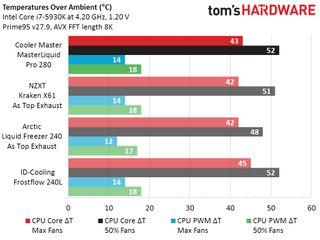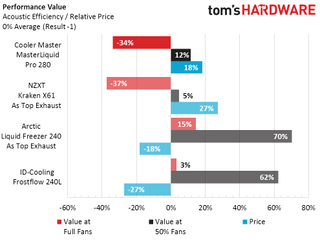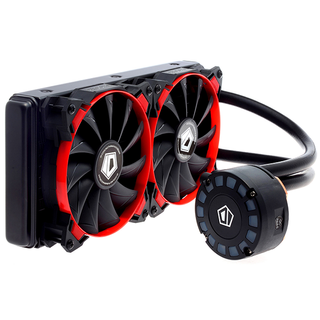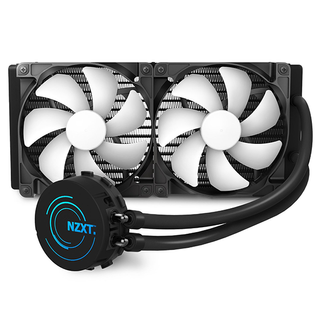Cooler Master MasterLiquid Pro 280 Cooler Review
Why you can trust Tom's Hardware
Test Methods, Results & Conclusion
We’re comparing the MasterLiquid Pro 280 to the similarly-sized NZXT Kraken X61, the quad-fan Arctic Liquid Freezer 240, and the surprisingly powerful Id-Cooling Frostflow 240L, using the hardware configuration from previous big cooler reviews, at both 100% and 50% fan settings via motherboard firmware, to maintain result consistency.
Comparison Products
Test Results
The MasterLiquid Pro 280 hangs tough with the Kraken X61 and Liquid Freezer 240, but the smaller and cheaper Frostflow 240L is nipping at the heels of higher-priced rivals.

The MasterLiquid Pro 280 has the fastest fans, and appears to have the fastest pump at over 9,000 RPM. Nobody heard any screaming noises from the pump, so the “Tach 2” speed shown assumes that the pump sends a tach signal four times per cycle.

The MasterLiquid Pro 280 is noisy, but then again so are two of its competitors. The Liquid Freezer 240 is by no means quiet, but its four slower fans produce fewer decibels of sound pressure on an A-weighted scale.

It looks like those seeking the best cooling-to-noise ratio should start stacking mid-speed fans, based on the Freezer 240 results. Many cases don’t have room to create a radiator sandwich however, and for those that do the ultimate acoustic efficiency would likely result from spending more money to add more fans to the larger radiators (and turning down the speeds).

The smaller 2x 120mm radiators typically cost less, with a price difference that exceeds the performance difference (in percentage terms). We aren’t using temporary discounts in this chart.

For deal seekers, the “killer value” could come from those temporary discounts we didn’t include. The MasterLiquid Pro 280 has recently been selling for as little as $100, and the Kraken X61 for as little as $120. The steeper MasterLiquid Pro 280 discount could make it the perfect part for a case that has a 2x140mm fan mount, but doesn’t have space for a stack of fans such as the Liquid Freezer 240 used to hit its performance marks. Of course, anyone who has room for both the wider radiator and two layers of fans is welcome to try both . . . on their own.
MORE: Best CPU Cooling
MORE: How To Choose A CPU Cooler
MORE: All Cooling Content
Stay on the Cutting Edge
Join the experts who read Tom's Hardware for the inside track on enthusiast PC tech news — and have for over 25 years. We'll send breaking news and in-depth reviews of CPUs, GPUs, AI, maker hardware and more straight to your inbox.
-
10tacle I would have liked to see the $130 Corsair H115i EP thrown in the mix for comparison but overall an excellent review. We can't have too many CPU cooler reviews!Reply -
munizj1 The absence of a comparison to any Corsair AIO's or even NZXT's current X62 is...strange.Reply -
Crashman Reply
It would also be strange to include any coolers we haven't reviewed :)19717789 said:The absence of a comparison to any Corsair AIO's or even NZXT's current X62 is...strange.
-
the nerd 389 Reply19717789 said:The absence of a comparison to any Corsair AIO's or even NZXT's current X62 is...strange.
The x61 is essentially identical to the x62 except for the LEDs. -
JackNaylorPE Review covers the basics but ... did I miss it or was there any mention of radiator material ? Not commenting on what's there but what isn't. Methinks a cooler review needs to go beyond what can be found in the press release and a few comparisons with a couple of clone like designs. I read reviews to find out the things that the manufacturer intentionally leaves out. As for comparisons, the things I look for in a AIO cooler review are:Reply
a) Can it come close to the noise / thermal performance of the better / cheaper air coolers ?
b) Can it come close to competing w/ OLC type AIOs w/ copper rads and moderate speed fans ?
c) All materials.
d) And tho checking things like pump flow would be illuminating, it is recognized that you'd have to destroy the CLC to get this info ... but would be nice to know if manufacturer was forthcoming with this type of data.
Also would like to know more about the window that lets you see the coolant ...not seeing a value if you don't like what you see, you can't you do anything about it. Wish this was fleshed out some. -
the nerd 389 Reply19719425 said:Review covers the basics but ... did I miss it or was there any mention of radiator material ? Not commenting on what's there but what isn't. Methinks a cooler review needs to go beyond what can be found in the press release and a few comparisons with a couple of clone like designs. I read reviews to find out the things that the manufacturer intentionally leaves out. As for comparisons, the things I look for in a AIO cooler review are:
a) Can it come close to the noise / thermal performance of the better / cheaper air coolers ?
b) Can it come close to competing w/ OLC type AIOs w/ copper rads and moderate speed fans ?
c) All materials.
d) And tho checking things like pump flow would be illuminating, it is recognized that you'd have to destroy the CLC to get this info ... but would be nice to know if manufacturer was forthcoming with this type of data.
Also would like to know more about the window that lets you see the coolant ...not seeing a value if you don't like what you see, you can't you do anything about it. Wish this was fleshed out some.
For an AIO, the radiator material isn't as much of an issue. The loop is much more tightly controlled than open-loop designs. Any engineer worth their salt would ensure that if they use an aluminum rad, the rest of the components will either also be aluminum or galvanically isolated. That's nearly impossible to do in an open loop.
Regarding OLC coolers, the reviews are a few clicks away. The summary is basically that the Celsius S24 handily beats this cooler, and this cooler handily beats the other OLC options.
Lastly, it's fairly easy to check coolant flow without opening the loop. All you have to do is use the CPU power and instantaneous coolant temperature change to derive the heat capacity per minute. That translates directly into flow via mass per second and the heat capacity of water. That's easy if the coolant sensor is before the radiator, but requires removing the fans and wrapping the radiator if the sensor comes after the radiator. It's worth noting that above about 0.2 GPM, coolant flow doesn't really come into play until you push a lot of heat into the loop, and then double up on the fans and run them at full speed. -
brucewithatemper The $130 Corsair H115i EP would've been a great comparison for the review. But overall, great review! Keep em coming brother!Reply -
dstarr3 According to this, the Arctic Liquid Freezer 240 is the cheapest, the coolest, and the quietest. Sooooo... why buy anything else?Reply -
10tacle Reply19721291 said:According to this, the Arctic Liquid Freezer 240 is the cheapest, the coolest, and the quietest. Sooooo... why buy anything else?
Many people take more into consideration than just raw performance and noise. Warranty being one example. Both the Arctic Cooling and Cooler Master coolers only have a 2-year warranty compared to Corsair's 5-year warranty with their H115i EP (all Corsair closed loop coolers come with a 5-year warranty).
I for one would gladly spend $30 more on a cooler with a 5-year warranty...especially if it outperforms both the $90-$100 coolers (which it does). As well as I'd rather spend the same $100 on an H100i with a 5-year warranty even if it's behind the other coolers by a few C in performance. -
the nerd 389 Reply19721777 said:19721291 said:According to this, the Arctic Liquid Freezer 240 is the cheapest, the coolest, and the quietest. Sooooo... why buy anything else?
Many people take more into consideration than just raw performance and noise. Warranty being one example. Both the Arctic Cooling and Cooler Master coolers only have a 2-year warranty compared to Corsair's 5-year warranty with their H115i EP (all Corsair closed loop coolers come with a 5-year warranty).
I for one would gladly spend $30 more on a cooler with a 5-year warranty...especially if it outperforms both the $90-$100 coolers (which it does). As well as I'd rather spend the same $100 on an H100i with a 5-year warranty even if it's behind the other coolers by a few C in performance.
Fractal Design also offers a 5-year warranty. What's even better is that you don't void the warranty if you open the loop and expand it. It still covers the original components of the cooler.




